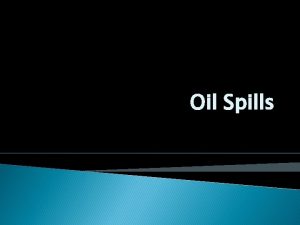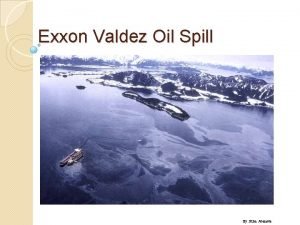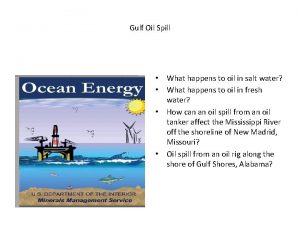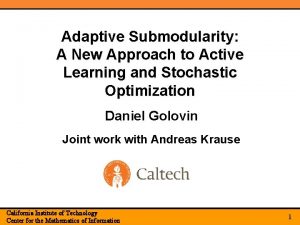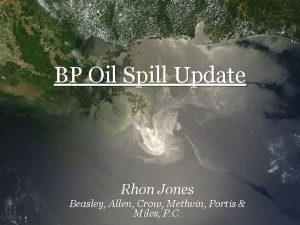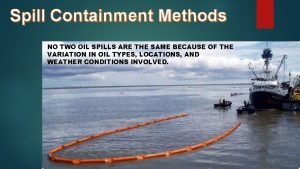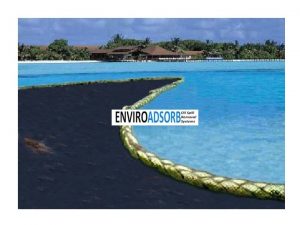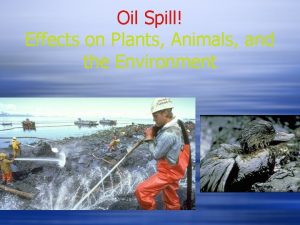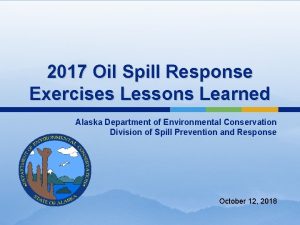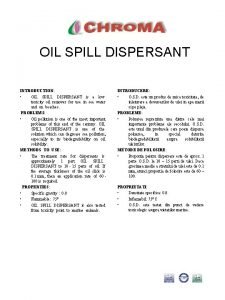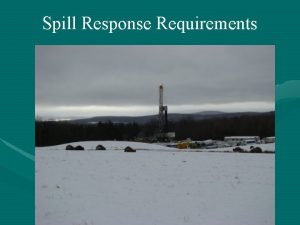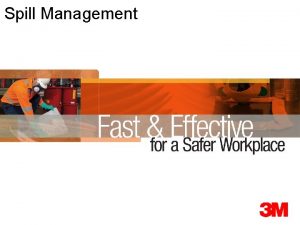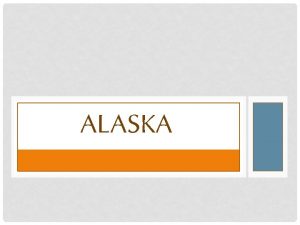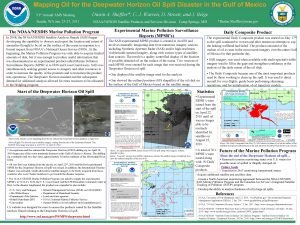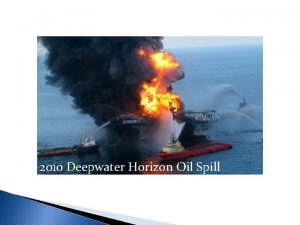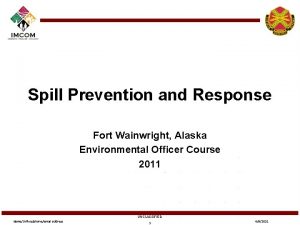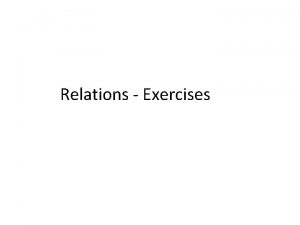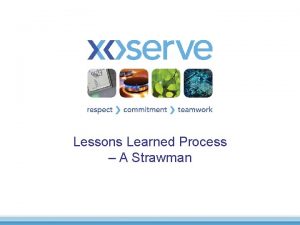2016 Oil Spill Response Exercises Lessons Learned Alaska

















- Slides: 17

2016 Oil Spill Response Exercises Lessons Learned Alaska Department of Environmental Conservation Division of Spill Prevention and Response May 15, 2017

Introduction ADEC is sharing the top lessons learned from oil spill response exercises to encourage continual improvement in oil spill response Aligns with feedback we received from stakeholders that participated in the Response Exercise Program Improvements Process Provides expectations for 2017 exercises 2 Exercise Lessons Learned – May 15, 2017

2016 Exercises – ADEC Participation ADEC participated in 36 exercises fulfilling both responder & evaluator responsibilities ¥ By type ¥ ¥ ¥ 3 4 IMT & Field 13 Field 19 IMT 31 Regulated 5 Unregulated Exercise Lessons Learned – May 15, 2017

Why lessons learned? ¥ What is a lesson learned? ¥ ¥ ¥ All exercises have lessons to be learned ¥ ¥ 4 Provides Specifics - WHY something worked or didn’t work What specific thing or action made the difference? Even the most successful and smallest exercises have lessons from which we all can learn Lessons learned can be items for improvement or innovative ideas Lessons learned provide considerations for improvement Lessons learned are more helpful when shared Exercise Lessons Learned – May 15, 2017

Top 2016 Lessons Learned ADEC selected the most common lessons learned that were notable for their importance and broad applicability Oil Discharge Prevention & Contingency Plan Familiarization Incident Management Team Training Communications Response Equipment Training Response Tactic Adjustment 5 Exercise Lessons Learned – May 15, 2017

Oil Discharge Prevention & Contingency Plan Familiarization Plan holder responders could be more familiar with their oil discharge prevention & contingency plans and refer to them for ¥ ¥ ¥ 6 Notification procedures Contact information Emergency actions checklists Facility diagrams Available equipment Exercise Lessons Learned – May 15, 2017

Incident Management Team Training ¥ Responders could use additional Incident Management Team (IMT) training to better understand the responsibilities of each Incident Command System position in order to implement their duties more effectively. Specific positions include ¥ ¥ 7 Incident Commander Section Chiefs Unit Leaders This ties closely to communications - If responders better understand their position specific duties & how their position relates to other sections and positions, then they know what to communicate and to whom for a more effective response Exercise Lessons Learned – May 15, 2017

Communications Communication is critical to response. Responders could communicate more frequently & share more information to ensure the response is able to progress effectively. The information to be passed from the Initial Incident Command to the Unified Command during the Incident Briefing should be as complete as is known at the time. Do not assume everyone already knows the information. The Planning Section & the Operations Section should be in close communications to ensure needed information is passed in a timely manner. The Operations Section & field command could communicate more frequently & with more detailed information to ensure the field receives the support it needs to continue the response & the Operations Section receives the information they need to continue to support the field and the Unified Command. 8 Exercise Lessons Learned – May 15, 2017

Response Equipment Training Field responders could use additional training on starting and operating the response equipment available onsite, including Pump priming & starting Attaching hydraulic hoses 9 Exercise Lessons Learned – May 15, 2017

Response Tactic Adjustment Tactics often need to be adjusted to be effective in that day’s conditions Things to consider to make your tactic more effective Environmental conditions Weather Tides & currents Shoreline composition Topography & drainage Spill trajectory Response equipment Right tactics for the conditions Responders should use their knowledge and understanding of how these considerations affect the tactics and be able to adjust accordingly to make the assigned tactic effective 10 Exercise Lessons Learned – May 15, 2017

Technology Don’t get hung up on IMT technology to the detriment of the response Sometimes analog methods are more effective 11 Ensures everyone can see the information Can be used anywhere, even on the side of a truck Can keep response progressing during computer or software Exercise Lessons Learned – May 15, glitches 2017

Cool Innovation Rebuilding or repairing your dock? Great time to consider how to make your response easier & better 12 Simple & effective dock to boom connection Dock was fitted with a curtain to prevent oil from traveling under the dock & out of containment Exercise Lessons Learned – May 15, 2017

ADEC Goals for 2017 Exercises ADEC will focus on the following goals for 2017 exercises PPRP involvement in exercise planning Equipment/tactic deployments Incident Action Plans ADEC will continue to gather & summarize lessons learned 13 Exercise Lessons Learned – May 15, 2017

Planning Exercises with ADEC involvement in exercise planning from the beginning ensures ADEC can participate The exercise will meet ADEC requirements Plan holders & ADEC should work together to: Develop 14 Exercise scope Date of the exercise Objectives Scenario Simulation inputs (if needed) Evaluation criteria Incorporate lessons learned from 2016 Exercise Lessons Learned – May 15, 2017

Equipment/Tactic Deployments Small equipment deployment exercises may include completing an ICS 201 Incident Briefing Actual deployment of equipment Ability to start, operate and deploy their initial response equipment Ability to effectively adjust tactics based on the conditions of the day and spill trajectory Validate response times identified in plan holder contingency plans 15 Exercise Lessons Learned – May 15, 2017

Incident Action Plans IMT exercises will include objectives related to Incident Action Plans (IAP) Consult with ADEC for extent of IAPs expected IAPs do not have to be pretty IMT exercise duration should be long enough to complete a usable IAP if developing an IAP is an objective of the exercise Key IAP documents expected 16 The intent is to document the processes for effective response management The IAP must be of sufficient quality to direct the next operating period effectively Site Safety Plan Waste Management Plan Stakeholder Engagement Plan Wildlife Plan Shoreline Cleanup Assessment Technique Plan Exercise Lessons Learned – May 15, 2017

Questions? Alaska Department of Environmental Conservation Spill Prevention & Response Division Prevention Preparedness & Response Program Training & Exercises Group 907 269. 3051

